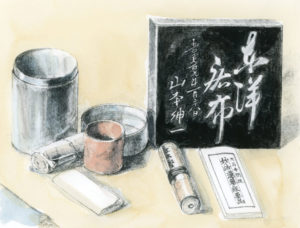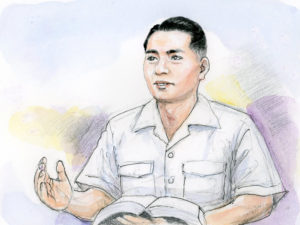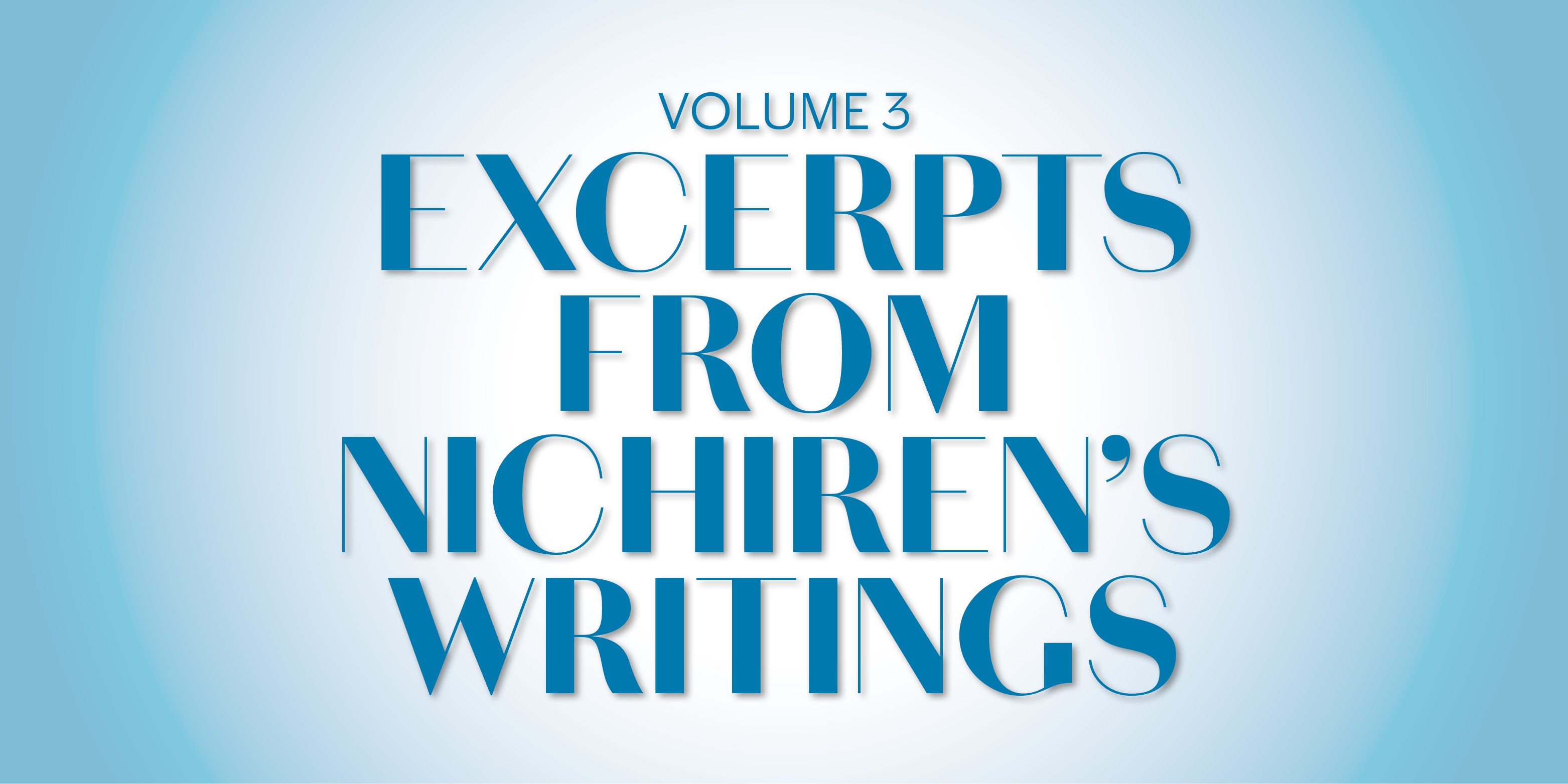This installment, published in the December 19, 2018, issue of the Seikyo Shimbun, focuses on passages from Nichiren Daishonin’s writings that SGI President Ikeda discussed in volume 3 of The New Human Revolution.
Passage 1
“The moon moves from the west eastward, a sign of how the Buddhism of India spread in an easterly direction. The sun rises in the east, an auspicious sign of how the Buddhism of Japan is destined to return to the Land of the Moon.” (“On Reprimanding Hachiman,” The Writings of Nichiren Daishonin, vol. 2, p. 936)
The Soka Gakkai Realized Nichiren Daishonin’s Prophecy

Illustration courtesy of Seikyo Press.
In January 1961, Shin’ichi Yamamoto embarked on his first steps in realizing the dream of kosen-rufu in Asia, cherished by his mentor, second Soka Gakkai President Josei Toda.
Similar passages [as the one above] also appear in “On the Buddha’s Prophecy” and other writings. Each predicts that Nichiren Buddhism will return to the west from Japan, meaning the spread of the correct teaching throughout Asia and the rest of the world. Josei Toda saw the realization of this prophecy as the Soka Gakkai’s mission—a mission he entrusted to Shin’ichi and the youth.
Had it not been for the Soka Gakkai, the original Buddha’s foretelling of the westward transmission of Buddhism would have undoubtedly remained unfulfilled.
Now, having just ushered in his first New Year’s as Soka Gakkai president, Shin’ichi was about to embark on that pioneering endeavor. It would be a historic step in the annals of Buddhism heralding the dawn of a new century of life in Asia. (The New Human Revolution, vol. 3, revised edition, p. 22)
■ ■ ■
“The Daishonin’s prophecy of kosen-rufu would be mere idealism if no one were to try to achieve it. It is wrong, I feel, to think that kosen-rufu will come about on its own if we simply wait for it to happen. Realizing the Daishonin’s prophecy hinges on the determination, powerful conviction and earnest action of those who come after him. As the Daishonin’s disciples, instead of waiting for his prediction to happen, shouldn’t we be determined to make it happen? If not, we would have nothing to strive for. For those who toil with this conviction, the Daishonin’s prophecy will be a profound source of confidence, courage and strength.” (NHR-3, revised edition, 84)
Passage 2PASSAGE 2
“If in a single moment of life we exhaust the pains and trials of millions of kalpas, then instant after instant there will arise in us the three Buddha bodies with which we are eternally endowed.” (The Record of the Orally Transmitted Teachings, p. 214)
Diligently Exert Ourselves

Illustration courtesy of Seikyo Press.
In the final days of their travels, the leaders accompanying Shin’ichi Yamamoto began to feel the fatigue of their long journey. Sensing this, he encouraged them based on Nichiren Daishonin’s writings.
“What Nichiren Daishonin indicates here,” Shin’ichi emphasized, “is that if we concentrate infinite millennia worth of effort into our prayer when chanting Nam-myoho-renge-kyo and exert ourselves earnestly in our Buddhist practice, we can bring forth the three enlightened properties of the Buddha at each moment of our lives. It also teaches us that chanting Nam-myoho-renge-kyo itself is the practice of diligently exerting oneself.
“While this passage gives expression to the state of life of the original Buddha, Nichiren Daishonin, in terms of our own lives, it means that if we exert ourselves and pray tirelessly for kosen-rufu, we cannot fail to bring forth Buddha wisdom and great life force. Thus it is possible to break through any deadlock and attain great victory. To achieve this, however, it is essential that we do not neglect making diligent efforts. We should always work, think and strive twice as hard as others.
“All of us are beginning to feel the fatigue of our long journey, but we must remember that this is an important guidance trip that heralds the dawn of kosen-rufu in Asia. If we encounter even one member, we must encourage that person with all our strength and being. This will pave the way for the future.
“Also, as we familiarize ourselves with the people, culture and circumstances of each country on this trip, we will have to think earnestly about what is needed to advance kosen-rufu there. If we don’t stay focused, our trip will be over and we won’t have accomplished a thing. Each moment is decisive.” (NHR-3, revised edition, 280–81)
The Buddhist View of Life and Death
The first installment of the “Westward Transmission” chapter in volume 3 of The New Human Revolution was published in the January 1, 1995, Seikyo Shimbun, the Soka Gakkai’s daily newspaper. Sixteen days later, on January 17, a magnitude 6.9 earthquake devastated the city of Kobe and surrounding areas of Kansai, resulting in the loss of 6,434 lives.
In the installment of this chapter that was published in the February 2, 1995, Seikyo Shimbun, there is a scene in which Shin’ichi Yamamoto talks about the Buddhist view of life and death, saying in part, “Those who have continually taken action for kosen-rufu throughout their lives as emissaries of the Buddha definitely will never sink into the depths of fear and suffering and experience the agonies of hell—irrespective of the circumstances under which they die” (NHR-3, revised edition, 53).
He goes on to say, “Those who have staunchly upheld faith in Nichiren Buddhism and attained Buddhahood in this life will, after death, immediately be reborn as human beings in places near the Gohonzon and once again savor the great joy of devoting their lives to kosen-rufu” (NHR-3, revised edition, 55).
Just as a tree that grows leaning eastward also topples eastward when it falls, Buddhism teaches that a person who strives wholeheartedly in faith, even if their life is cut short by an accident or unexpected event, will without doubt be reborn in good circumstances in their next life.
February 2, 1995, is also the day when SGI President Ikeda concluded various events overseas and returned to Japan, promptly visiting the Kansai area. At a February 4 memorial ceremony for the victims of the earthquake, Sensei cited the sutra passage, which states: “Even if you are killed by a mad elephant, you will not fall into the three evil paths. But if you are killed by an evil friend, you are certain to fall into them” (see “On Establishing the Correct Teaching for the Peace of the Land,” The Writings of Nichiren Daishonin, vol. 1, p. 11). Referring to this passage, he deeply encouraged and reassured all those gathered, stating: “Perishing in a disaster such as an earthquake is similar to being killed by a mad elephant. Those who strive in faith will definitely not fall into hell.”
Sensei’s encouragement and the Buddhist view of life and death he offered in The New Human Revolution ignited a great light of hope in the hearts of those who had lost their precious loved ones in the devastating Kobe earthquake.
You are reading {{ meterCount }} of {{ meterMax }} free premium articles

